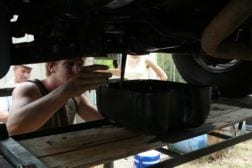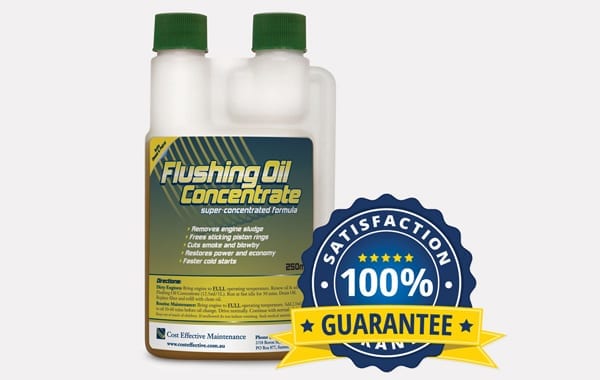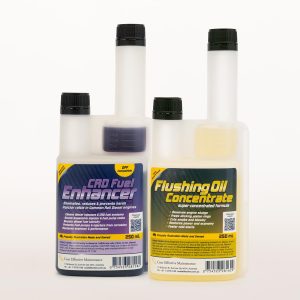Engine Sludge…Act quickly, or it’ll kill your engine.
Engine Sludge…Act quickly! Or it’ll kill your engine!
“Engine sludge is on the top of the agenda again…” Engine sludge affects both petrol and diesel engines, and is surprisingly common. Engine Sludge is a gooey, tarlike deposit that reduces or shuts off oil circulation and can mean thousands of dollars to repair or replace an engine that has seized. Sludge also directly causes oil consumption, power loss, high fuel consumption, oil pressure problems, hard starting, blow by and overheating. The problem is well recognized globally, by motoring authorities, and the mechanical servicing industry. In Europe, engine sludge is back to the top of the agenda again, for the first time in about 20years. Routine engine flushing has once again become the norm throughout both USA and Europe.
Cost Effective Maintenance first became aware of severe sludge issues with small diesel engines in the mid-1980, and successfully developed a Flushing Oil Concentrate to safely remove heavy, persistent engine sludge without dismantling engines…a major breakthrough in reducing costly repairs, labour and vehicle downtime.
Flushing Oil Concentrate will safely remove all built up engine sludge and old oil from your engine.
As simple as completing an oil change.
How common is engine sludge ?
The RACQ advise that sludge can affect almost any make of later model petrol engine and can cause extensive engine damage. Even high quality prestige vehicles have not been immune from the sludge demon with Lexus, Saab and Audi a few in that category. Globally, some 3.3 million Toyota engines have been sludge damaged, and Toyota have been involved in a major class action. Destroy these types of engines, and it’ll cost you $4000 to $8000.
Nowadays, a lot of modern low emission truck diesels e.g. Detroit Diesel Series 60, Cummins M11 and Signature engines, Caterpillar 3500 series engines, old Perkins, Detroit 2 strokes, Hinos, etc that can suffer sludge problems join the ranks.
Older mechanical type diesel engines, commonly used in 4x4s & light commercials come with rebuild costs of $6000-8000. Later model common rail type diesels cost around $15,000. Truck type diesels, such as Detroit Series 60 will cost over $20,000 to rebuild. Large mining type engines will see you out of pocket by $250,000 upwards. We all know that oil is an engine’s life blood. If sludge prevents its flow, the result WILL be very expensive. Fortunately, there is a window of opportunity to remove accumulated engine sludge, before an engine seizes, and with regular, effective flushing the risk of further sludge damage can be avoided.
Sludge is an aviation safety risk!There are serious safety concerns within the aviation industry. Les Lyons is a CASA engine technical specialist. He reports that “a Piper PA-28 Warrior operating under visual flight rules in the UK, suffered a crankshaft fracture and resultant loss of the propeller in flight. The event resulted from oil sludge initiated corrosion inside the crankshaft front bore. Combustion by-products combine with water accumulating in the sump through condensation. The resulting mixture of combustion by-products, water and oil is highly corrosive.”
According to Lyons, “Having a propeller fall off in front of your eyes is one thing, not being able to feather the prop on a failed engine in a twin prop can be just as frightening. The most common reason for a piston engine aircraft propeller not feathering is oil sludge. Engine oil sludge builds up inside the propeller hub to a level where the feathering mechanism cannot overcome the sludge build up.”
How can you safely remove engine sludge ?
Fortunately, CEM’s Flushing Oil Concentrate (FOC) makes the solution very cheap and so easy that anyone who changes their own oil can do it. FOC is formulated on purpose specific detergents which directly target normally persistent sludge and also heavy deposits of carbon that have accumulated, which can cause piston ring sticking and power loss. All these deposits are dissolved and suspended in the oil to be safely removed. FOC will literally restore pristine cleanliness to the engine crankcase. In most cases, one flush is all it takes. The 30 minute job is detailed below…
 |
Step 1. Drain the old oil out hot. That way you remove as much contaminant as possible first up & you get the best possible clean up result. Matt shows us how on his 1998 Hilux 3.0L diesel, which has 268,000 kms on it. |
 |
Matt just purchased the Hilux, and the dealer had changed the oil about 500 kms ago. Just look how filthy it has become in such a short time! It’s pretty clear that this oil would not last its full service period. It would stain your hands by 1000kms, from my experience…and if it stains your hands, it can’t keep the engine clean!! |
 |
Step 2. Add fresh oil to the engine. You can use a cheap oil for this part of the job. Run the engine to warm up the oil, and then add the Flushing Oil Concentrate (125mL for 10L oil capacity). The Hilux takes 6 L oil, so Matt added about 75mL Flush. Landcruisers and Patrol 4.2L diesels need 125mL for a 10L sump. Series 60 Detroits need 500ml for 40L sump. |
 |
Step 3. Run the engine at a fast idle parked up for 30 minutes. For most 4x4s, this means 1500-2000rpm. For Larger truck type motors (eg Series 60 Detroits, Cats, Macks, Cummins, etc), run at about 1200 RPM |
 |
With, brand new oil and FOC, and see how it looks after 30 minutes. It’s picked up all the old persistent sludge from around valve gear, oil galleries, etc, and hard baked on carbon from piston ring grooves, skirts, oil coolers etc. This oil is pretty dirty, but the engine crankcase (the oil wetted side) is now very clean! |
 |
Step 4. Drop the oil again, and watch all the build up muck go out with the flush. |
 |
Step 5. Add a good quality engine oil and new filter, and it will now easily last for the whole recommended oil service period. At this stage, many customers choose to also add the AW10 Antiwear to the oil for added protection, and quieter running. Engines love it! They rev more freely and run so smoothly and quietly…it’s a feel good thing! |
 |
Step 6. As a final check, make sure there are no leaks, take it for a quick run and recheck the oil level. In Matt’s case, he found it very difficult to even see the oil on the dipstick. That’s it on the left. It took a few attempts to even photograph it properly. Once you’ve got it clean, just put a small amount of FOC in the old oil 30 minutes before you drop it out. For the Hilux, that’s a mere 15mL an oil change. So cheap and yet so effective! |
Congratulations! You’ve got yourself a clean crankcase and clean oil. That’s a great start to obtaining long engine life. Other things you should aim for are clean air and fuel (replace filters regularly), clean fuel injection system (use a quality injector cleaner regularly), and clean combustion and exhaust spaces (use FTC Decarbonizer to clean up these deposits).
Recommended product to flush out engine sludge …
-
Value Packs
Flushing Oil Concentrate & Cleanpower Value Pack
From $135.00 incl. GSTSelect options This product has multiple variants. The options may be chosen on the product page -
Value Packs
Flushing Oil Concentrate & CRD Fuel Enhancer Value Pack
From $135.00 incl. GSTSelect options This product has multiple variants. The options may be chosen on the product page -
Engine Blowby, Engine Overheating, Main-products, Oil Additives, Oil Sludge Remover, Our Products
Flushing Oil Concentrate for Diesel and Petrol Engines
From $115.00 incl. GSTSelect options This product has multiple variants. The options may be chosen on the product page






